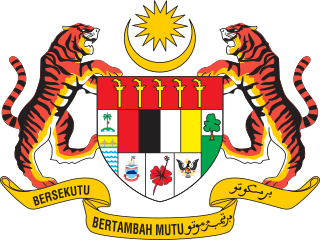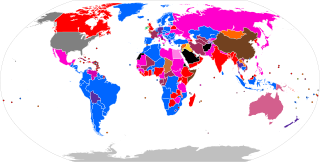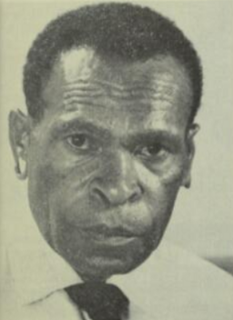Plurality voting is an electoral system in which each voter is allowed to vote for only one candidate, and the candidate who polls the most among their counterparts is elected. In a system based on single-member districts, it may be called first-past-the-post (FPTP), single-choice voting, simple plurality or relative/simple majority. In a system based on multi-member districts, it may be referred to as winner-takes-all or bloc voting. The system is often used to elect members of a legislative assembly or executive officers. It is the most common form of the system, and is used in most elections in the United States, the lower house in India, elections to the House of Commons and English local elections in the United Kingdom.
Proportional representation (PR) characterizes electoral systems in which divisions in an electorate are reflected proportionately in the elected body. If n% of the electorate support a particular political party as their favorite, then roughly n% of seats will be won by that party. The essence of such systems is that all votes contribute to the result—not just a plurality, or a bare majority. The most prevalent forms of proportional representation all require the use of multiple-member voting districts, as it is not possible to fill a single seat in a proportional manner. In fact, PR systems that achieve the highest levels of proportionality tend to include districts with large numbers of seats.

The single transferable vote (STV) is a proportional voting system designed to achieve or closely approach proportional representation through voters ranking candidates in multi-seat organizations or constituencies. There are various ways of counting votes under STV, as described below.

The Australian electoral system comprises the laws and processes used for the election of members of the Australian Parliament. The system presently has a number of distinctive features including compulsory enrollment, compulsory voting, majority-preferential instant-runoff voting in single-member seats to elect the lower house, the House of Representatives, and the use of the single transferable vote proportional representation system to elect the upper house, the Senate.

Electoral systems for the legislatures of the individual Australian states and territories are broadly similar to the electoral system used in federal elections in Australia.

Elections in Malaysia exist at two levels: federal level and state level. Federal level elections are those for membership in the Dewan Rakyat, the lower house of Parliament, while state level elections are for membership in the various State Legislative Assemblies. The heads of executive branch at both the federal and state levels, the Prime Minister and Menteri Besar/Chief Ministers respectively, are indirectly elected, usually filled by a member of the majority party/coalition in the respective legislatures.

Elections in Lithuania, are held to select members of the parliament, the president, members of the municipal councils and mayors, as well as delegates to the European Parliament. Lithuanian citizens can also vote in mandatory or consultative referendums.
The Edmonton provincial electoral district existed in two incarnations from 1905 - 1909 and again from 1921 - 1955, with the city broken up into multiple constituencies in the other time-periods. The district was created when Alberta became a province, to encompass residents of the city of Edmonton on the northside of the North Saskatchewan River. For a time, it was one of three multi-member constituencies in the province's history, the others being Calgary and Medicine Hat.
The term swing refers to the extent of change in voter support, typically from one election or opinion poll to another, expressed as a positive or negative percentage point. For the Australian House of Representatives and the lower houses of the parliaments of all the states and territories except Tasmania and the ACT, Australia employs preferential voting in single-member constituencies. Under the full-preference instant-runoff voting system, in each seat the candidate with the lowest vote is eliminated and their preferences are distributed, which is repeated until only two candidates remain. While every seat has a two-candidate preferred (TCP) result, seats where the major parties have come first and second are commonly referred to as having a two-party-preferred (TPP) result. The concept of "swing" in Australian elections is not simply a function of the difference between the votes of the two leading candidates, as it is in Britain. To know the majority of any seat, and therefore the swing necessary for it to change hands, it is necessary to know the preferences of all the voters, regardless of their first preference votes. It is not uncommon in Australia for candidates who have comfortable leads on the first count to fail to win the seat, because "preference flows" go against them.
There are a number of complications and issues surrounding the application and use of single transferable vote proportional representation that form the basis of discussions between its advocates and detractors.
The Borda count is a family of single-winner election methods in which voters rank options or candidates in order of preference. The Borda count determines the outcome of a debate or the winner of an election by giving each candidate, for each ballot, a number of points corresponding to the number of candidates ranked lower. Once all votes have been counted the option or candidate with the most points is the winner. The Borda count is intended to elect broadly acceptable options or candidates, rather than those preferred by a majority, and so is often described as a consensus-based voting system rather than a majoritarian one.

An electoral system or voting system is a set of rules that determine how elections and referendums are conducted and how their results are determined. Political electoral systems are organized by governments, while non-political elections may take place in business, non-profit organisations and informal organisations. These rules govern all aspects of the voting process: when elections occur, who is allowed to vote, who can stand as a candidate, how ballots are marked and cast, how the ballots are counted, limits on campaign spending, and other factors that can affect the outcome. Political electoral systems are defined by constitutions and electoral laws, are typically conducted by election commissions, and can use multiple types of elections for different offices.
A localized list or local list is a technique used under systems of party-list proportional representation to determine which party candidates are elected from the party list. Local lists differ from open lists or closed lists. As with open lists, local lists allow the electorate to vote for individual candidates, but that preference is expressed through local or district level election processes. Closed lists do not allow voters to express such a preference. Voters vote only for the party.

Parliamentary elections were held in Yugoslavia on 26 March 1950. They were the first held under communist rule; the Communist Party of Yugoslavia had seized full power soon after the 1945 elections, when it abolished the monarchy and declared Yugoslavia a republic.

The 2020 Irish general election took place on Saturday 8 February, to elect the 33rd Dáil Éireann, the lower house of Ireland's parliament. All but one of the 160 seats were contested, with the Ceann Comhairle (speaker) being returned automatically. The members, Teachtaí Dála (TDs), were elected by single transferable vote from all of the multi-member constituencies. The election was called following the dissolution of the 32nd Dáil by the president, at the request of the Taoiseach, Leo Varadkar, on 14 January 2020. It was the first election since 1918 to be held on a weekend.
This is a list of members of the House of Assembly of Papua and New Guinea from 1964 to 1968. The House of Assembly had of 34 open electorates, 10 electorates reserved for non-indigenous members and 10 official members. The non-official members had been elected at the 1964 election.

General elections were held in the Territory of Papua and New Guinea between 15 February and 15 March 1964. They were the first elections in the territory held under universal suffrage. Voter turnout among enrolled voters was 65%.

A by-election for Kaindi constituency was held in the Territory of Papua and New Guinea between 16 July and 15 August 1966.

Ugi Biritu was a Papua New Guinean politician. He served as a member of the House of Assembly between 1964 and his death in 1967.

Atiheme Kimi was a Papua New Guinean politician. He served as a member of the House of Assembly between 1972 and 1973.










